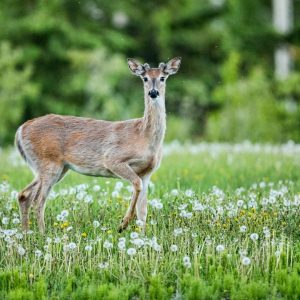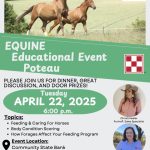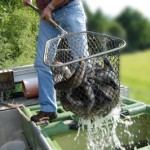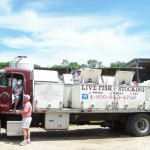 The deer herd has survived the winter and early spring and is entering the most energy and nutrient demanding period of the year. Bucks have antlers developing, does are finishing gestation and starting to lactate, and fawns are growing at their peak rate.
The deer herd has survived the winter and early spring and is entering the most energy and nutrient demanding period of the year. Bucks have antlers developing, does are finishing gestation and starting to lactate, and fawns are growing at their peak rate.
Buck Nutrition
By late spring, most bucks are already growing antlers. Not only is antler growth energy demanding, but nutrient intake is critical as well. The growing antler is 80% protein and 20% ash (mineral)2 and the bucks require high-quality dietary protein to be able to reach their genetic potential for antler growth. This increased energy and nutrient demand will continue until the antlers harden in the fall.
Doe Nutrition
During late spring, the doe hopefully is pregnant with at least twin fawns. During the last third of gestation (pregnancy), approximately the last 67 days of a 200-day gestation period3 the fawns grow the most and the does’ energy and nutrient requirements increase as well.4 When fawns are born, the does energy and nutrient requirements further increase to support milk production. Milk production peaks 10-37 days after fawning5. During lactation, a doe with twin fawns will have a 54% and 36% increase in energy and protein requirements, respectively, compared to late gestation4. During early lactation, the fawns’ demand for milk puts a significant demand on the doe’s resources that often causes the doe to lose body condition, especially if the doe is already in poor condition1. To help maintain the doe’s body condition during lactation, supplemental feeding will offset changes in native forage availability. Fawn survival and growth is dependent on milk consumption. If the doe does not receive sufficient nutrition, the amount of milk produced may be inadequate for the fawns, resulting in reduced growth rates and reduced survival. Towards the end of summer, milk production begins to decrease with an associated decrease in energy and nutrient needs and the fawns are weaned and eating dry feed.
Fawn Nutrition
Fawns grow at the most rapid rate early in life. Fawns begin foraging when they are a few weeks old and become functional ruminants at about two months of age6 and therefore high-quality nutrition in the form of native forage or supplemental feed will help the fawns reach their full growth potential.
If areas are over-populated or if the summer is hot and dry, available native forage could become limiting. As discussed, the summer is a nutritional demanding period for bucks, does, and fawns. Ensuring adequate nutrition is critical to support antler development, lactation and growth. Supplemental feeding will help the animals meet their energy and nutrient requirements.



